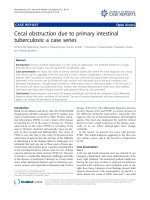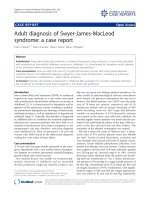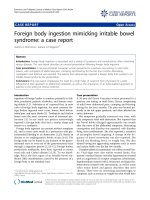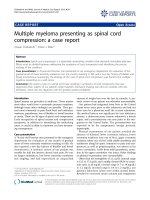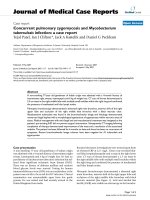Báo cáo y học: "Abdominal only CPR during cardiac arrest for a patient with an LVAD during resternotomy: A case report" pps
Bạn đang xem bản rút gọn của tài liệu. Xem và tải ngay bản đầy đủ của tài liệu tại đây (955.82 KB, 4 trang )
CAS E REP O R T Open Access
Abdominal only CPR during cardiac arrest for
a patient with an LVAD during resternotomy:
A case report
Eric M Rottenberg
1
, Jarrett Heard
2
, Robert Hamlin
3
, Benjamin C Sun
4
and Hamdy Awad
5*
Abstract
We present a case in which a patient with a previous sternotomy and left ventricular assist device (LVAD)
implantation developed cardiac arrest during resternotomy for LVAD exchange. The surgeon refused chest
compressions for fear of potential damage to the inflow cannula directly beneath the sternum. The perioperative
team had no alternatives to external cardiac massage other than rapid deployment of extra-corporeal membrane
oxygenation for mechanical support, so the anesthesiologist advised the nursing personnel to perform abdominal
only cardiopulmonary resuscitation while the surgeon performed a femoral bypass to cannulate the groin for extra-
corporeal membrane oxygenation support.
Background
Cardiac arrest during cardiac surgery is a unique situa-
tion. In 2009, the European Society of Cardiothoracic
Surgery published a separate guideline that addressed
these particular situations, including the timing of emer-
gency resternotomy, the number of attempts at defibril-
lation before reopening, the administration of
epinephrine, and emergency resternotomy sets [1]. How-
ever, this guideline did not address the treatment of
patients with a mechanical assist device in cardiac arrest
situations since their treatment is highly complicated.
Cardiac arrest may be due to mechanical failure and
external cardiac massage (ECM) is not appropriate, as
stated by the European Society of Cardio thoracic Sur-
gery [1].
We present a case in which the patient with a pre-
vious sternotomy and LVAD (HeartMate II, Thoratec
Corporation) implantation developed cardiac arrest dur-
ing resternotomy for LVAD exchange due to hemolysis.
The surgeon denied chest compressions for fear of
potential damage of the inflow cannula directly beneath
the sternum. As there were no alternatives to ECM
offered by the American Heart Association and the Eur-
opean Society of Cardiothoracic Surgery [1,2] other than
rapid deployment of extra-corporeal membrane oxyge-
nation (ECMO) for mechanical support, we performed
abdominal only cardiopulmonary resuscitation (AO-
CPR) while the surgeon performed a femoral bypass to
cannulate the groin for ECMO support.
Case Presentation
A 56-year-old male with multiple co-morbidities, includ-
ing a long-standing history of non-ischemic dilated car-
diomyopathy, stage III chronic kidney disease, and
congestive hepatopathy, underwent LVAD implantation
two months prior to the most recent admission. He
returned to the hospital due to persistent atrial fibrilla-
tion, progressively worsening dyspnea on exertion and
rest, abdominal distension with ascites, and suspected
ongoing hemolysis due to positioning of the inflow can-
nula at the apex of the LVAD.
It was decided that the patient should return to the
operating room for placement of a n ew LVAD due to
hemolysis and hypotension refractory to medical man-
agement. The night before the scheduled surgery, the
patient was intubated due to worsening cardiopulmon-
ary parameters, including increased work to breathe,
and maintained on epinephrine 0.15 mcg/kg/min, nore-
pinephrine 0.1 mcg/kg/min and dobutamine 3 mcg/kg/
min. He was transferr ed to the operating room to
replace the pump. Pre-op vitals included: temp 37.6
degrees Celsi us, arterial blood pressure 64/50, mean
* Correspondence:
5
The Ohio State University Medical Center, Department of Anesthesiology,
N411 Doan Hall, 410 West 10
th
Avenue, Columbus, OH, 43210, USA
Full list of author information is available at the end of the article
Rottenberg et al. Journal of Cardiothoracic Surgery 2011, 6:91
/>© 2011 Rottenberg et al; licensee BioMed Central Ltd. This is an Open Access article distributed under the terms of the Creat ive
Commons Attribution License (http:/ /creativecom mons.org/licenses/by/2.0), which permits unrestricte d use, distribution, and
reproduction in any medium, provided the origina l work is properly cited.
arterial pressure 55, heart rate 118 and respiratory rate
of 16. Prior to induction of anesthesia, labs included:
white blood cells 15.2, hemoglobin 10, hematocrit 29.4,
platelets 96, Na+ 130, K+ 3.1, Cl- 95, CO
2
25, blood
urea nitrogen 24, creatine 2.08, glucose 84, and interna-
tional normalized ratio 3.5. Preoperative arterial blood
gases were pH 7.48, pCO
2
35.9, pO
2
184.2, and HCO
3
26.1. In the operating room, hemodynamic parameters
were con tinuously monito red via radial arterial line and
Swan-Ganz catheter. Induction was uneventful with eto-
midate 10 mg and cisatracurium 10 mg. The transeso-
phageal echocardiography (TEE) probe was placed
uneventfully. The surgeons entered the mediastinum
using the previous sternal incision. Once they began dis-
secting out the mediastinum, the patient became
severely hypotensive and asystolic, and the TEE did not
detect any moveme nt on both the left and right side of
the heart.
The anesthesiologist alerted the surgeon that Advanced
Cardiac Life Support (ACLS) protocol was needed and
the surgeon communicated that chest compressions were
contraindicated due to the position of the inflow cannula
directly beneath the sternum. The anesthesiologist
recommended AO-CPR with manual mid-abdominal
compressions 1 to 2 inches left of midline (left parame-
dian) at a rate of 80 beats/min with maximal force while
the surgeon cannulated the groin to provide long-term
mechanical support in the form of ECMO. As instructed,
two members of the team performed AO-CPR (Figure 1).
During ACLS, the patient continued to be mechanically
ventilated and epinephrine, vasopressin, and sodium
bicarbonat e were given per ACLS protocol, and the
hemodynamic parameters as a result of AO-CPR contin-
ued to be monitored (Figure 2). The duratio n of the CPR
was 15 minutes, during which time the surgeon was able
to cannulate the femoral artery and vein and institute
ECMO support. Th e chest was closed and the patient
was transferred to the intensive care unit. The patient
spent 24 hours in the intensive care unit on ECMO sup-
port and mechanical assist device. A decision was made
to withdraw care after 24 hours and the patient expired.
Our case represents a difficult situation where the
perioperative team faced a new challe nge in the oper at-
ing room: what are the alternativ es to ECM when chest
compressions are contraindicated due to position of the
inflow cannula directly beneath the sternum? Neither
the new guidelines published in the European Journal of
Cardiothoracic Surgery in 2009 nor the American Heart
Association in 2010 providedalternativestoECMfor
patients with a mechanical assist device.
It became evident that there was a need for an alter-
native to ECM, such as AO-CPR, to protect the recent
sternotomy until re-opening of the chest to provide
internal cardiac massage. The Interactive Cardiovascular
Thoracic Surgery e-community conducted a discussion
to address whether AO-CPR could be used instead of
ECM to either protect the recent sternotomy or while
chest compressions are not possible during resternot-
omy [3]. After reviewing this evidence, Dunning et al.
[1] concluded that AO-CPR theoret ically has the poten-
tial to provide adequate systemic perfusion while an
emergency resternotomy is being performed, but further
Figure 1 Abdominal only cardiopulmonary resuscitation during
cardiac arrest in patient with HeartMate. Abdominal only
cardiopulmonary resuscitation using a left paramedian technique 1
to 2 inches left of the midline while the surgeon performs
cannulation of the femoral artery and vein for placement of extra-
corporeal membrane oxygenation for long-term mechanical
support.
Figure 2 Monitor after 15 minutes of abdominal only
cardiopulmonary resuscitation. Monitor showing the
hemodynamic waveforms and their means during abdominal only
cardiopulmonary resuscitation during cardiac arrest while the
surgeon performed cannulation of the femoral artery and vein as
shown in Figure 1. Coronary perfusion pressure: Mean arterial
pressure (MAP) - central venous pressure (CVP) = 15 mmHg.
Rottenberg et al. Journal of Cardiothoracic Surgery 2011, 6:91
/>Page 2 of 4
evidence is needed before it can be recommended for
routine use.
In general, coronary perfusion pressure during cardiac
arrest is the difference between pressure in the aorta
(from which the coronary arteries arise) and the right
atrium (into which the coronary arteries exit). Using a
mathematical model to describe the biophysics of cardio-
pulmonary resuscitation with periodic z-axis acceleration
or abdominal compression at aortic resonant frequencies,
Babbs [4] proposed that differences in wave mechanics,
resulting from simultaneous c ompression of the abdom-
inal aorta and the inferior vena cava, produced differ-
ences in pressure between the aorta and right atrium.
During CPR, the minimal coronary perfusion pressure
considered necessary for successful resuscitation with
return of spontaneous circulation (ROSC) is 15 mmHg
[5]. The values f or mean aortic and central venous pres-
sure for our patient were 77 and 62 mmHg, respectively,
which provided a mean coronary perfusion pressure of
15 mmHg (77 to 62 mmHg). In a study of 100 patients,
however, conventional CPR provided a mean CPP of only
12.5 mmHg [5]; thus, we propose that the abdominal
only CPR in our patient could hav e served as an effective
bridge between the arrest and initiation of ECMO.
In our case, AO-CPR was unplanned, but the surgeon
refused chest compressions due to contraindications in
this patient. Due to lack of alternatives for resuscitation
other than ECMO in this patient, the anesthesiologist
suggested that AO-CPR be performed as a temporary
resuscitative effort until the surgeon could successfully
cannulate the femoral artery and vein to provide long-
term mechanical support. Two rescuers performed AO-
CPR with generation of coronary perfusion pressure
(CPP) of 15 mmHg for 15 minutes, the duration of resus-
citation. Both achieved results that appeared to be identi-
cal. The evidence seems to suggest that AO-CPR in this
particular situation may be comparable to ECM in gener-
ating adequate CPP, but at this point it is still too early to
determine the true efficacy of AO-CPR compared to
ECM with regards to ROSC and neurological outcome.
Other evidence of adequate CPP generated during
AO-CPR includes that from Geddes and colleagues [6]
and Pargett et al. [7] who compared AO-CPR with chest
compressions in animal models, and showed that AO-
CPR was equivalent or superior to standard chest com-
pressions at providing coronary perfusion. Neither of
these studies reported any visceral organ damage or
contraindications to AO-CPR, nor did they comment on
neurological outcome. At this time, we cannot comment
on the efficacy of AO-CPR on neurological outcomes as
neurological status could not be assessed in our patient
because he was intubated, sedated and paralyzed until
care was withdrawn.
This case report generates important concerns. In our
patient, even though we gene rated a CPP of 15 mmHg,
which has been shown in some patients to be adequate,
we do not know whether it was adequate to allow
ROSC or whether the ECMO was responsible for
ROSC. Other concerns are: what is the optim al delivery
(optimal rate, depth/force, duty cycle and location of
hand position) of AO-CPR in achieving successful resus-
citation with ROSC, what is the best strategy for ventila-
tion during AO-CPR, and is there potential damage/
injury to abdominal viscera during AO-CPR?
Conclusions
In conclusion, this case demonstrated an example
where, due to contraindications to ECM in a patient
with a mechanical assist device, we were able to success-
fully provide an alternative means of CPR. This alterna-
tive technique was done with no delay and without
creating wound dehiscence while the surgeon was work-
ing, achieving adequate perfusion as measured by CPP,
mean arterial pressure and systolic blood pressure, and
providing a bridge to ECMO support. As a result, we
believe that further animal and human studies need to
be performed before the technique can be adopted as a
valid method of resuscitation in this unique situation.
Consent
Obtaining consent was a difficult endeavor since the
patient died during his hospitalization at our institution
in 2010. We contacted the Institutional Review Board
(IRB) and spoke with an exempt analyst, Ms. Sherry Pet-
tey, whose contac t information is listed below, who said
that we did not need IRB approval for submission of the
case report. Per the request of the Journal of Cardi-
othoracic Surgery, we attempted to contact the patient’s
next of kin, his wife. Unfortunately, the only number
listed has been disconnected and we were unable to find
another listing to try and reach her. We also contacted
his former place of employment to determine if it had
any contact information of family or next of kin, which
also could not provide us with any current contacts. As
such, we believe that we performed our due diligence in
getting informed consent, but due to the time lapse
between the events surrounding the case and the cur-
rent submission of the case report as w ell as the physi-
cal passing of the patient, we were unsuccessful in
obtaining informed consent.
Sherry Pettey
1960 Kenny Rd
300 Research Foundation Building
Columbus, OH 43210
614-688-0389
Rottenberg et al. Journal of Cardiothoracic Surgery 2011, 6:91
/>Page 3 of 4
Abbreviations
ACLS: advanced cardiac life support; AO-CPR: abdominal-only
cardiopulmonary resuscitation; CPP: coronary perfusion pressure; CPR:
cardiopulmonary resuscitation; ECM: external cardiac massage; ECMO: extra-
corporeal membrane oxygenation; LVAD: left ventricular assist device; ROSC:
return of spontaneous circulation; TEE: transesophageal echocardiography.
Acknowledgements
We thank Keri Hudec who provided technical editing services on behalf of
the Department of Anesthesiology.
Author details
1
301B Fenway Road, Columbus, OH, 43214, USA.
2
The Ohio State University
College of Medicine, 370 West 9
th
Avenue, Columbus, OH, 43210, USA.
3
The
Ohio State University College of Veterinary Medicine, 1900 Coffey Road,
Columbus, OH, 43210, USA.
4
The Ohio State University Medical Center,
Department of Surgery, Division of Cardiothoracic Surgery, N847 Doan Hall,
410 West 10
th
Avenue, Columbus, OH, 43210, USA.
5
The Ohio State
University Medical Center, Department of Anesthesiology, N411 Doan Hall,
410 West 10
th
Avenue, Columbus, OH, 43210, USA.
Authors’ contributions
All authors have read and approved the final manuscript.
ER: Designed the study, conducted the study, analyzed the data, and wrote
the manuscript.
JH: Analyzed the data and wrote the manuscript.
RH: Designed the study, conducted the study, and analyzed the data.
BS: Conducted the study.
HA: Designed the study, conducted the study, analyzed the data, and wrote
the manuscript.
Competing interests
The author declares that they have no competing interests.
Received: 13 April 2011 Accepted: 15 July 2011 Published: 15 July 2011
References
1. Dunning J, Fabbri A, Kolh PH, Levine A, Lockowandt U, Mackay J, Pavie AJ,
Strang T, Versteegh MI, Nashef SA, EACTS Clinical Guidelines Committee:
Guideline for resuscitation in cardiac arrest after cardiac surgery. Eur J
Cardiothorac Surg 2009, 36:3-28.
2. Vanden Hoek TL, Morrison LJ, Shuster M, Donnino M, Sinz E, Lavonas EJ,
Jeejeebhoy FM, Gabrielli A: Part 12: cardiac arrest in special situations:
2010 American Heart Association Guidelines for Cardiopulmonary
Resuscitation and Emergency Cardiovascular Care. Circulation 2010, 122:
S829-S861.
3. Adam Z, Adam S, Khan P, Dunning J: Could we use abdominal
compressions rather than chest compression in patients who arrest after
cardiac surgery? Interact Cardiovasc Thorac Surg 2009, 8:148-151.
4. Babbs F: Biophysics of cardiopulmonary resuscitation with periodic z-axis
acceleration or abdominal compression at aortic resonant frequencies.
Resuscitation 2006, 69:455-469.
5. Paradis NA, Martin GB, Rivers EP, Goetting MG, Appleton TJ, Feingold M,
Nowak RM: Coronary perfusion pressure and the return of spontaneous
circulation in human cardiopulmonary resuscitation. JAMA 1990,
263:1106-1113.
6. Geddes LA, Rundell A, Lottes A, Kemeny A, Otlewski M: A new
cardiopulmonary resuscitation method using only rhythmic abdominal
compression: a preliminary report. Am J Emerg Med 2007, 25:786-790.
7. Pargett M, Geddes LA, Otlewski MP, Rundell AE: Rhythmic abdominal
compression CPR ventilates without supplemental breaths and provides
effective blood circulation. Resuscitation 2008, 79 :460-467.
doi:10.1186/1749-8090-6-91
Cite this article as: Rottenberg et al.: Abdominal only CPR during
cardiac arrest for a patient with an LVAD during resternotomy: A case
report. Journal of Cardiothoracic Surgery 2011 6:91.
Submit your next manuscript to BioMed Central
and take full advantage of:
• Convenient online submission
• Thorough peer review
• No space constraints or color figure charges
• Immediate publication on acceptance
• Inclusion in PubMed, CAS, Scopus and Google Scholar
• Research which is freely available for redistribution
Submit your manuscript at
www.biomedcentral.com/submit
Rottenberg et al. Journal of Cardiothoracic Surgery 2011, 6:91
/>Page 4 of 4



